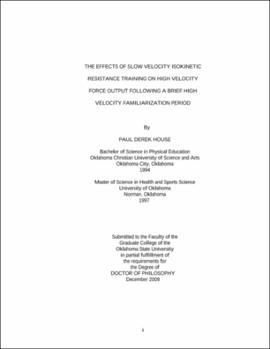| dc.contributor.advisor | Smith, Douglas | |
| dc.contributor.author | House, Paul Derek | |
| dc.date.accessioned | 2013-11-26T08:34:33Z | |
| dc.date.available | 2013-11-26T08:34:33Z | |
| dc.date.issued | 2009-12 | |
| dc.identifier.uri | https://hdl.handle.net/11244/7438 | |
| dc.description.abstract | Scope and Method of Study: The purpose of this study was to determine the effects of slow velocity resistance training on maximal torque output at high velocities following a brief high velocity familiarization period. Twenty two healthy college age males (n = 9) and females (n = 13) with a mean age of 22.9 � 2.885 years old were randomly selected into either a control (n = 11) or treatment (n = 11) group. The treatment group performed 3 sets of 10 maximal repetition knee extensions with their non-dominate leg, three times per week, at 30 degree sec-1, for seven weeks. The final week of training was accompanied by one set of 10 repetitions at 300 degree sec-1 which was referred to as the familiarization training. The control group did not participate in the training, but did perform the familiarization sets during the final week. Both groups performed two sets of 10 repetitions at 30, 60, 120, 180, 240, and 300 degree sec-1 as practice prior to commencing the study. Both groups were tested for maximal torque output at 30, 60, 120, 180, 240, and 300 degree sec-1 pre, after six weeks, and post-training. A 2 x 3 (Group x Time) MANOVA was conducted. Following the analysis of the overall MANOVA, interactions and main effects were assessed. If significant main effects and/or interactions occurred, time contrasts were used to determine which dependent variables contributed to the significant effect(s) at the various times. Since there were no group differences, repeated measures ANOVA was used to separate groups in order to measure changes over time within each group. Bonferroni adjustment was used when the same dependent variable was measured multiple times. | |
| dc.description.abstract | Findings and Conclusions: The results of the 2 x 3 (Group x Time) MANOVA showed a significant omnibus effect with a Wilks' Lambda = 0.093, F(6, 15) = 24.37, p< 0.0001. Further MANOVA analysis showed no interaction of group x time and no main effect for group. However, there was a significant main effect for time, p = 0.0333. With both groups combined, all six velocities showed significant increases in maximal torque overtime with: 30 degree sec-1, p = 0.0055; 60 degree sec-1, p = 0. 0059; 120 degree sec-1, p = 0. 0104; 180 degree sec-1, p = 0. 002; 240 degree sec-1, p = 0. 0002; and 300 degree sec-1, p = 0. 0004. The results indicate that brief exposure to isokinetic resistance training results in rapid and general increases in maximal torque output independent of routine training. These adaptations appear greatest at higher velocities. | |
| dc.format | application/pdf | |
| dc.language | en_US | |
| dc.rights | Copyright is held by the author who has granted the Oklahoma State University Library the non-exclusive right to share this material in its institutional repository. Contact Digital Library Services at lib-dls@okstate.edu or 405-744-9161 for the permission policy on the use, reproduction or distribution of this material. | |
| dc.title | Effects of slow velocity isokinetic resistance training on high velocity force output following a brief high velocity familiarization period | |
| dc.contributor.committeeMember | Edwards, Steven | |
| dc.contributor.committeeMember | O'Brien, Matthew | |
| dc.contributor.committeeMember | Miller, Janice | |
| osu.filename | House_okstate_0664D_10638 | |
| osu.accesstype | Open Access | |
| dc.type.genre | Dissertation | |
| dc.type.material | Text | |
| dc.subject.keywords | degrees per second | |
| dc.subject.keywords | isokinetic resistance | |
| dc.subject.keywords | torque | |
| thesis.degree.discipline | Health and Human Performance | |
| thesis.degree.grantor | Oklahoma State University | |
